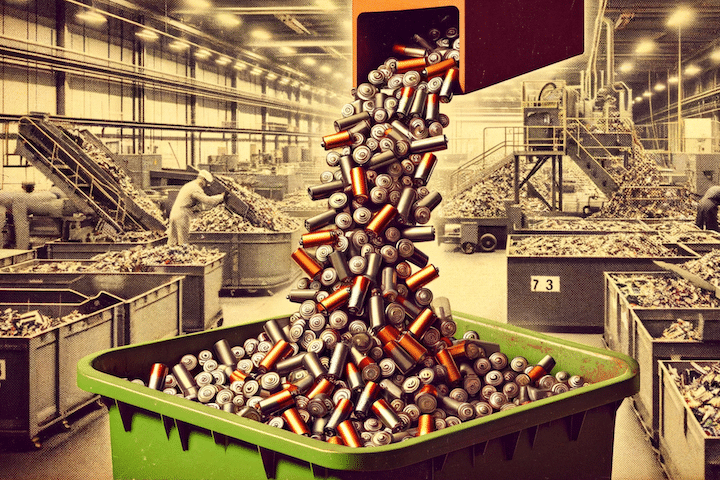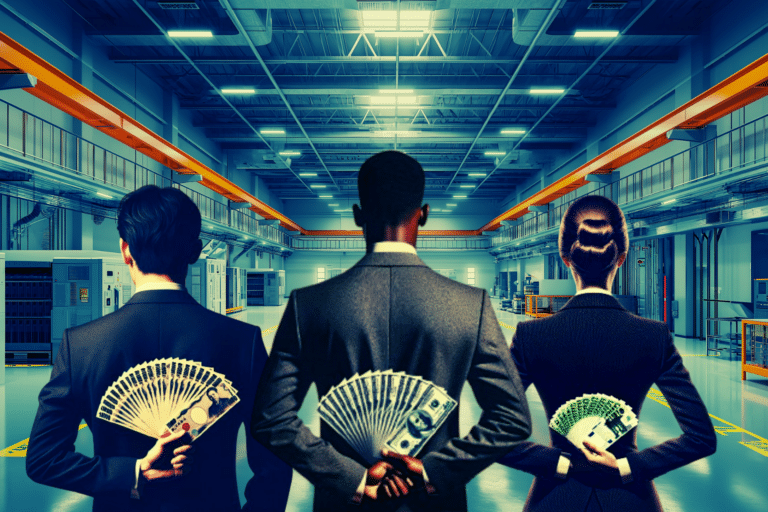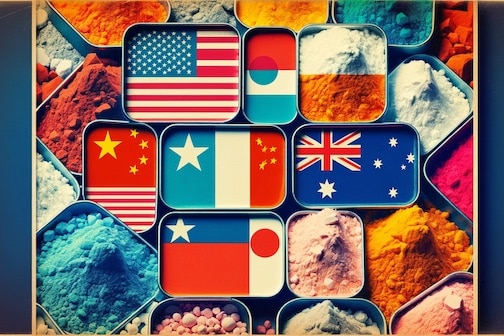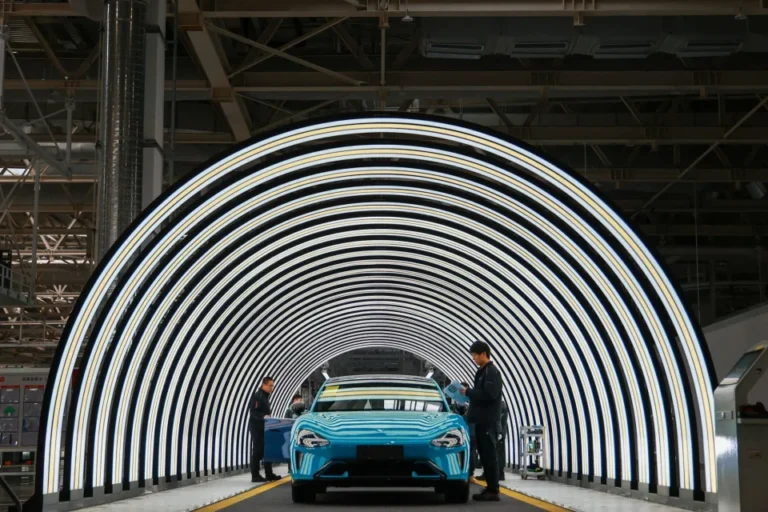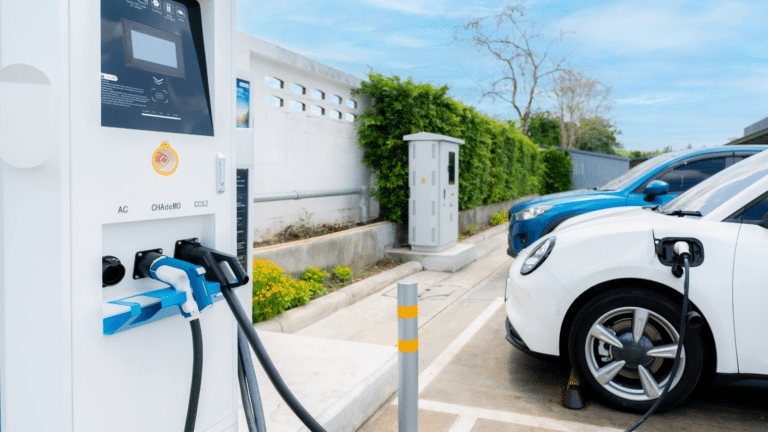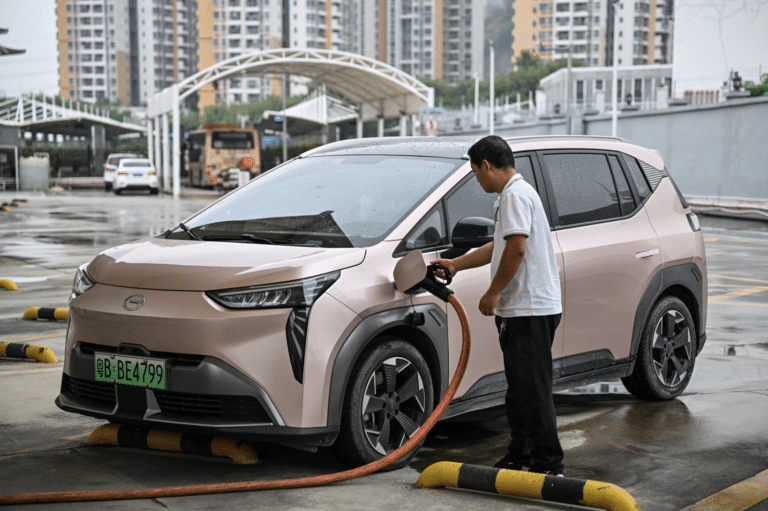Melissa Lott: [00:00:01] Over the past two years, we’ve all become familiar with this term supply chain issues. The pandemic has created these shortages all over the world for all sorts of things from home gym equipment to roller skates. But in March of 2021, if you tried to order a Snuggie and c’mon, you know what I’m talking about. It’s that blanket with the armholes in the front. It’s something that I’ve honestly always wanted to try. Well, if you ordered that Snuggie in March, you probably had tough luck for reasons that were totally unrelated to COVID 19. [00:00:30][29.3]
Maria Gallucci: [00:00:31] CNN reported that there were $550,000 worth of Snuggie, the wearable blanket that were stuck in the Suez Canal. [00:00:37][6.3]
Melissa Lott: [00:00:38] This is Maria Gallucci. She’s a journalist with Canary Media and she writes a lot about the shipping industry. In March, one of the biggest container ships in the world got stuck in the Suez Canal. It was a ship named the Ever Given. And Maria knew it was going to be a really big story. [00:00:53][14.5]
Newsreel: [00:00:54] One of the companies looking. [00:00:54][0.8]
Maria Gallucci: [00:00:55] To break free, this massive. [00:00:56][1.4]
Newsreel: [00:00:57] Container ship says it could take weeks to dislodge it. It can’t get over how colossal this thing is. Just look at one of the big is trying to get it free. It looks like a toy. Next to that ship. [00:01:09][11.9]
Maria Gallucci: [00:01:10] The Suez Canal, is this crucial maritime artery. It connects the Red Sea to the Mediterranean. And it’s essentially a shortcut between Asia and Europe. Rather than having to go around the tip of Africa. [00:01:21][11.4]
Melissa Lott: [00:01:22] If we zoom out for a minute, we see that about 10% of all global trade travels through the Suez Canal. And now we have this massive ship that’s lodged right in the middle of it, holding up all the other ships behind it. That’s hundreds of ships that would normally pass through. It was this global traffic jam. And it wasn’t just snags. It made existing shortages for all kinds of products worse. I’m talking everything from clothes and food to oil and even semiconductors. [00:01:47][24.6]
Maria Gallucci: [00:01:48] It actually exacerbated a shortage of garden gnomes. [00:01:51][2.9]
Melissa Lott: [00:01:58] That’s right. And garden gnomes. So what happened here? It was actually this freak dust storm that forced the ever given to hit ground, which means that a single storm had a massive impact on global supply chains. And it really underscores how much we rely on maritime shipping to keep the economy moving. See, we need these ships to carry around lots of stuff. And in recent years, these ships have been getting bigger and bigger. In fact, on average, over the past 20 years, they’ve doubled in size. [00:02:27][28.9]
Maria Gallucci: [00:02:28] The ever given weighs over 200,000 tons. It’s in over 1300 feet long. So it’s like longer than the Empire State Building stands tall. And so it’s not just any other container ship. It’s massive. It’s one of the biggest in the world. [00:02:43][15.6]
Melissa Lott: [00:02:44] Bigger ships mean more goods, but they also mean something kind of surprising. They mean more efficient shipping. And as we work to decarbonize the shipping industry, this efficiency can really help us to get that Snuggie to your couch with less greenhouse gas emissions and less toxic air pollution. These giant ships tell us something about what it’s going to take to decarbonize this largely invisible, yet essential part of the economy. This is the big switch, a show about how to rebuild the energy systems that are all around us. To slow climate change, we need to transform our buildings, homes, cars and the economy as quickly as possible. But how do we do it right? I’m Dr. Melissa Lott, and I’m the director of research at Columbia University’s Center on Global Energy Policy. And I study the technologies and systems that power our world. In this episode, we’re talking about big ships and. [00:03:42][58.0]
Maria Gallucci: [00:03:46] I think shipping is one of those things that is definitely out of sight, out of mind for most people. [00:03:51][5.4]
Melissa Lott: [00:03:52] Maria has been writing about shipping for a long time, but when she tells people about her work, not everyone understands why on earth she finds it so interesting. [00:03:59][7.6]
Maria Gallucci: [00:04:00] There’s a little bit of like, Huh? That’s how I imagine they’re saying, That sounds really boring. Y. [00:04:05][4.9]
Melissa Lott: [00:04:06] But here’s the thing Behind the majority of objects that are in our physical world, there’s a cargo ship and these ships carry 11 billion tonnes of goods each year. About 90% of the world’s goods at some point end up on a cargo ship. Despite this, unless you live near a port, to most of us, shipping is pretty invisible items while they just sort of show up on store shelves or they get delivered to our front doors and we don’t hear much about how they got there. Unless, of course, a story like the ever given makes headlines. [00:04:35][29.1]
Maria Gallucci: [00:04:38] And when there’s a story like this in the headlines, it’s sort of just an interesting opportunity for people to kind of really think about it in a way and like, wow, yeah, these ships are massive and and the things that they’re carrying are things that I use in my everyday life. [00:04:54][15.2]
Melissa Lott: [00:04:54] And this big industry also means big carbon emissions. Every year, the shipping industry contributes 3% of total greenhouse gas emissions. [00:05:02][8.1]
Maria Gallucci: [00:05:03] If the shipping industry were a country, it would be the sixth largest emitter. [00:05:07][3.4]
Melissa Lott: [00:05:07] And so there’s been increasing pressure on the industry to tackle its emissions sooner rather than later. Which brings us back to the ever given one of the biggest ships in the world. [00:05:15][7.9]
Maria Gallucci: [00:05:16] So the ever given is part of this trend toward what are called mega ships making ships even bigger. And the justification that shipbuilders ship owners give is that if we make ships even larger, we can put more cargo on them, and that therefore reduces the amount of fuel used and greenhouse gas emissions created for every individual unit of cargo. [00:05:40][23.8]
Melissa Lott: [00:05:44] Increasing the efficiency of shipping is great, but even the most efficient ships will still emit carbon unless we do more. So how do we cut the rest of carbon on a shipping and how can shipping get to net zero in time to meet global targets? We talked to someone who focuses on the answers to these types of questions. Do you remember where you were when you first heard about the ever given getting stuck in the Sierras? [00:06:06][21.7]
Newsreel: [00:06:06] I’m pretty sure I would have been sitting at my desk because I get like lots of wonky shipping news every morning. [00:06:11][4.6]
Melissa Lott: [00:06:12] This is if O’Leary lawyer, economist and the CEO of Opportunity Green. She gets these wonky shipping newsletters every day because she’s worked for years on understanding the environmental and climate impacts of the shipping industry and like the rest of us. She also saw the memes and. [00:06:26][14.6]
Newsreel: [00:06:27] There was all these great beams going around. So we did one for climate change, which was like, you know, on the ever given itself was like, Oh, shipping’s climate problem. And then for that little digger down the bottom we had and the regulations that are trying to address it. I went out on her Twitter. It was great. [00:06:44][17.0]
Melissa Lott: [00:06:44] I saw that meme. [00:06:45][0.6]
Newsreel: [00:06:45] Yeah, quite proud of that. Yeah. [00:06:47][1.2]
Melissa Lott: [00:06:48] Ethan I explored the technological and political changes that can help us to make zero carbon shipping possible. How many ships are we really talking about having globally? Like, how many do we have today? [00:06:58][10.7]
Newsreel: [00:06:59] There’s there’s about 90,000 at the moment. Definitely over the past three or four years, the order book of ships. So the number of ships are not because it takes 3 to 4 years to build a ship. The order books have not been going up partially because of climate change, because shipping companies have kind of gone well, oh, I can’t yet order a ship that runs on a zero emission fuel. I don’t necessarily want to order one that runs on oil because in fairness, they do see that when regulation comes in, they could be caught holding this asset that is, you know, cost them millions and they may not be able to use it anymore. [00:07:37][37.6]
Melissa Lott: [00:07:38] At the highest level. What are when we talk about decarbonizing shipping, what are we talking about doing? What are the big steps we would need to take to decarbonize shipping? [00:07:45][7.1]
Newsreel: [00:07:45] Well, so what I guess is there’s two buckets to me. So one is the things that we can do right now for all of the ships that are out in the ocean. And then the other is kind of as we move forward and have new ships and new fuels. So for the ones that we can do right now, the main thing would be to slow down so ships because they’re moving through water. If you slow down, you actually there’s this cubic relationship with the water and the power and emissions and but anyway, you slow down, you cut your emissions quite dramatically. And it’s really interesting because of the way the shipping industry is organized or set up that quite often you have contracts that say, Oh, you must arrive in the port of L.A. on this date. But it doesn’t necessarily mean that there’s room for you to actually like go into the port and offload your containers so they could speed quite quickly across the ocean to get to L.A. And then they say outside L.A., which is a real shame and sort of slowing down and taking that journey slower and emitting less emissions. The other big thing, there’s various different efficiency tweaks I would say that ships can do. We could reduce a third of emissions from the shipping industry today just using efficiency technologies like that’s huge and it’s untapped. Some of them require things like new coating on the hull, but a really big one is using wind technology. So, you know, a long time ago all shipping was using sails. We used to just use the wind and then we moved into coal and now we’re on oil. So let’s move back to the wind. And wind could be responsible for about 20, 25% of the propulsion of ships. There’s all kinds of new technologies like fracking or rotors and kites. So they’re not just, I guess, the old sails that you think of, They’re some of them are these, you know, giant steel kind of turbines on ships, but capture the wind and provide the power and all this kind of good stuff. So those are, I would say, the kind of big efficiency slash propulsion improvements we could do on ships that exist today. But those ships still use oil. And so ultimately, we need to move away from oil and we need new fuel. So most of the research that we have on future fuels shows that we’re going to move into some kind of hydrogen fuel. So what we would do is use renewable energy to produce a huge amount of energy and then convert that into a liquid fuel that can go on the ship. And that might be hydrogen itself, it might be ammonia, it could potentially be methanol. And there’s various different reasons why you go for each one. There’s different inputs. But one of the main things is using renewable energy to produce these fuels so that they’re actually green fuels. And there are, I would say. Fuels that the some parts of the industry call transition fuels, and they use gas as if moving from oil to gas is really going to solve anything in climate change. We need to go the full way to renewable energy. And that’s one of the things that if you think about these giant ships, they could actually run on solar power. As long as you convert that solar power into liquid fuels, which is absolutely doable. And one of the huge benefits of that is there is loads of renewable energy potential around the world. And shipping is a global industry. So in the places around the world where they have a lot of capacity to produce this renewable energy, you could get shipping to pay a premium to produce those fuels, use it in shipping and a lot of investment and jobs and green growth goes into developing countries around the world. [00:11:36][230.3]
Melissa Lott: [00:11:36] Yes, I’m hearing things like changing our fuels, but becoming more efficient with our with our designs. When we think about all the ships that are out there right now and the fact that a new ship that has just hit the ocean will be out there for a few decades, what is the relative role of retrofitting existing ships versus switching design so that everything else that comes out into the ocean is zero carbon ready to go from day one? [00:12:01][24.2]
Newsreel: [00:12:01] Yeah, we’ve got to do both. Is the short answer to that really. We need standards to ensure that every new ship built today is ready to use zero emission fuel. But on top of that, we’re definitely going to have to retrofit quite a large part of the current fleet. And I guess one of the really important things for me as well, because we’re talking about this and it’s a global industry, making sure that no country is left behind because there are certain parts of the world that rely on shipping, I would say far more than I guess the global north does necessarily. So I’m thinking especially of Pacific Islands, which rely on ferries for their kind of day to day transport and making sure that whatever the new technology fuels, etc. are, that they go to those parts of the world as well. And so that’s one of the reasons I would say retrofitting is so important, because if we just have all of these wonderful new shiny vessels, which, you know, we need, but they will probably go the most profitable routes. And what you could end up doing, which we’ve seen in other industries, is that the old technology essentially gets left in a part of the world where they already have a lot of depravation, air pollution, etc.. And so we really need to be very, very careful around the equity and making sure that it’s not just a global north transition, but that the entire world transitions. [00:13:30][89.1]
Melissa Lott: [00:13:31] I think it’s a really important point because when we’re going to net zero, that is net zero around the world and making sure that we’re not leaving groups behind. How should we think about net zero when it comes to shipping? I mean, what are the significant differences between going to net zero and shipping versus reducing sulfur or reducing emissions a little bit? [00:13:52][20.7]
Newsreel: [00:13:53] Well, I would say we don’t really want to think about net zero at all in shipping. We want to just think about zero, absolute zero. And the reason I say that is net zero is a term that makes sense when you have parts of your economy where you are putting emissions out and also where you can suck in emissions like what we call sinks, I guess, in climate change terminology. But international shipping as a sector doesn’t have any of those sinks. There’s no you know, there’s no ships around the world that are soaking up emissions. That’s just not a thing. I mean, maybe one day we’ll find the technology to do that or sell ships around the world with trees on them. I don’t know. But as it currently stands, we just want to get to absolute zero. And we can do that because the technologies exist. As I’ve mentioned, if you use renewable energy, you convert that into hydrogen or ammonia or another fuel that’s zero emission. So you don’t need the net. And when you start talking about net zero and shipping, there’s then that question, well, okay, if we don’t have trees or other sinks, what does that mean? Are we then just offsetting our emissions, as in, would the shipping industry pay some other sector to decarbonize, which in theory is not necessarily wrong. It’s just that all sectors need to go to zero. And so if you leave a whole portion of the shipping industry not going to zero, then other sectors are going to have to work much harder. And we just we don’t have available carbon budget. You know, most of the analysis that we have today actually relies on carbon removals generally. So there’s no yeah, there’s not there’s no fluff in the carbon budget for shipping to just keep some of its emissions. It’s just got to go to absolute zero. [00:15:38][104.9]
Melissa Lott: [00:15:38] We talk a lot about the technologies that we can deploy to get shipping to zero carbon. But let’s step into the regulations and the rules. So who regulates shipping? What are the organizations that we really need to be aware of there? [00:15:50][11.6]
Newsreel: [00:15:51] So to start from the global and then work down. So there is the International Maritime Organization, which is based here in London, which is one of the reasons I’m based in London, so I can easily access it. And the COVID times, everything’s online, but it is a global regulator for shipping. So basically it’s one of the only sectors. Aviation’s the other one that has its own U.N. agency, and it was originally established to do things like safety to help regulate trade around the world. But increasingly it’s having to deal with climate change because it’s such a huge issue and obviously is taking up a lot of time. Having said that, they have not yet come out with any very impressive regulations. I can go into what they are doing, but the International Maritime Organization itself is composed of the countries around the world. So 175 countries are members, so not quite all countries. And they come together and they just discuss, well, what are we going to do about climate change from shipping? But apart from the IMO, every country also has its own ability to regulate shipping. Whether it does or not is a whole other question. So the European Union is moving into the space and is definitely starting to do and has the most impressive proposals on climate change and shipping in the world. I would say the US has signaled now under the Biden administration that they’re interested in doing something on shipping as well, and we’ll see where else moves. China, very interestingly, while they haven’t done anything on climate change and shipping, have moved on air pollution and shipping because air pollution in China is just a huge issue and they recognize that the amount of air pollution from shipping is quite large. And so they have brought in regulations that I guess kind of amplify what the IMO is doing in that area. So there’s there’s various different levels and shipping is not wireless, it’s got its own characteristics. It’s not, you know, something that we need to reinvent the wheel for. So the way I describe shipping a lot of the time is if you think about the wind industry 20, 30 years ago, so you would have had basically what were these giant wind farms that were incredibly expensive to build but would reduce greenhouse gases. And it wasn’t really in any one person’s interest to build them. Also, if you were the investor in that wind farm, you want to be guaranteed that you’re going to get a return. So our governments around the world did, especially in the EU, was they put a little charge on everyone’s electricity bill and that went into a part which funded the build out of these large wind farms. And then over time, as we built more and more of them, the costs of them came right down to where it is now. And today wind is one of the cheapest forms of energy, and that price came down much faster than anyone predicted. Like, it’s really interesting to go back and look at the price predictions and see how wrong we were in a good way, which is, in fairness, very rare for climate change. So that’s kind of a very useful way to look at international shipping because ships are these huge expensive things that you need to invest in that are going to last 20 to 30 years so we can put a charge on all of the fuel that shipping uses now on the oil and then use that money to pay for the clean, new shiny zero emission ships that should bring down the cost of those shiny ships, those clean ships. And then over time, I would hope that they would get much cheaper. And then that price on the emissions on the fuel that they use today can come down as well. So it’s carbon pricing, right? Like it’s not reinventing the wheel. It’s something we’ve done in lots of industries. [00:19:43][232.4]
Melissa Lott: [00:19:44] Here to name one or two regulations or technology shifts that would really get shipping on the path we need it to be to stabilize around the 1.5 degree number we talk about with the Paris Agreement. What would be the the top two. [00:19:58][14.1]
Newsreel: [00:19:59] The number one I would name is a concrete proposal that is in the IMO right now from the Marshall Islands and the Solomon Islands. They’re the sponsors, as we call it in the IMO for a carbon levy of $100 on every tonne of fuel, that $100 would go partially, as I mentioned before, to help de-risk the investment in zero emission vessels. But also importantly, it would go to developing countries around the world to ensure that the increased cost in trade wouldn’t disproportionately impact their economies. So what I mean by that is essentially shipping at the moment facilitates trade. Around the world. Right. So if you make shipping more expensive, you’ve just made trade more expensive. And for countries that are high volume exporters, that can actually be a real issue if they have if they’re if they’re less economically developed. So using some of that money is really, really important. And it’s just also the right thing to do. Coming back to shipping, being a global industry, we have to make sure that it’s equitable as we transition and that no country is left behind. And it’s no coincidence that that proposal comes from the Marshall Islands, the Solomon Islands, who, you know, as nations are literally fighting for their survival right now. So that would be my first number one policy. And then my second one would be a fuel standard. So we know already what fuels we’re going to go to. There’s some questions over, I guess, exactly what the mix is going to be, you know, but we know and we could definitely put in place a regulation that looks at those fuels on a full lifecycle basis. But you can put in place a standard that would start to tighten that over time. And we could design that in line with 1.5. And then you’ve got a clear trajectory down. And at the same time, then you’re generating this revenue that will support the transition and support the countries around the world. So it’s like it’s very clear to me and I would say like almost everyone who works in this area, that those are two regulations that would work. But unfortunately, we’re still at the stage where a lot of countries are saying, well, you know, we need to think about it a bit more. We need to discuss what if. Well, you know, and unfortunately, we just don’t have that kind of time. We really need to get these regulations in now. Ships last 20 to 30 years. So really, we need to get them in yesterday and we know they work. We’ve seen them in other sectors. So it’s time to bring them into shipping as well. [00:22:37][158.3]
Melissa Lott: [00:22:38] What is the worst case for zero carbon shipping look like? Like what is what is the worst case when we think about the future of shipping? [00:22:46][8.0]
Newsreel: [00:22:47] I guess it’s business as usual. I mean, it’s pretty bad as we are now. I guess the worst case is we don’t take any of this efficiency gains that we could do right now. We don’t move to future fuel. And in addition to that, I would add, you know, the rest of the world doesn’t decarbonize. So we’re still shipping around oil. And while we ship that we cause emissions, we’re still shipping around coal and causing emissions while we ship the coal around. So that’s yeah, it’s quite a bleak future. I would also say obviously the the oil, coal gas that we ship around is quite an obvious climate problem that we need to we need to stop doing that. But also think about the amount of meat we ship around the world, the amount of animal feed. Are those things that we should be doing similarly, like consumer goods and plastics? Can we start to reduce our consumption of those? Can we start to, you know, rewear our clothes a lot more then using fast fashion and getting rid of them every week. So there’s all these kind of like little things that we don’t really know what business as usual looks like for the shipping industry, because in the past it’s always been tied to kind of world trade. GDP growth. Shipping is just a reflection of that. But hopefully in the future that will no longer be true, that that will be decoupled, shipping will decarbonize, other sectors will decarbonize. We might be shipping a lot less around the world. And that actually makes me really excited because I think there’s a yes on days where I’m like, Oh my God, we’re never going to decarbonize the shipping industry. I’m like, It’s okay, because maybe every other sector will decarbonize, So shipping will just cease to be as important as it is now. Who knows? But I think that’s also if you’re in the shipping industry, if you want to stay relevant, if you want to continue to build your business and you want to keep the likes of, you know, Amazon, IKEA, Unilever, which have made these commitments, you have to decarbonize and you can definitely wait and oh, well, there’s no regulation yet. And is it really in my interest to move first? Well, yes. Yes, it is. Get out there ahead and be the first effect that change that investment and showing the others how it’s done. I have no doubt will pay off and put you in the right place for when the regulations come, because they are definitely coming in. People like me are not going to give up until they’re in place or so need to be. [00:25:22][154.8]
Melissa Lott: [00:25:22] So if the worst case for shipping is that we don’t take advantage of these near-term low hanging fruit efficiency gains, we just don’t take advantage of them. And we delay the overall transition for a long, long, long time. You know, as the rest of the world decarbonize, the shipping just becomes the laggard that we don’t move on. If that’s the worst case scenario, what’s the best? Case scenario for zero carbon shipping. What does that look like? Paint me a picture. [00:25:47][24.7]
Newsreel: [00:25:51] Well, I think the best case is really within our reach in that. So the EU I’ve mentioned is regulating and that’s happening right now. It’s going through the European Parliament is going through the European Council. It’s not as ambitious as it could be, but there is a lot of different members of the European Parliament, EU member states that want to make it more ambitious and that will be the first real regulation anywhere in the world that properly tackles climate change from shipping. So that to me could be our key pinch point that unlocks a lot of these efficiency technologies that we’re not using. That really sets us up to move to these alternative fuels. That makes wind not just an add on, but an absolute essential for every single ship. So that to me is the best case scenario that shipping gets out ahead of the rest of decarbonization in the world. And I would also say, I mean, I focus on the EU as this regulation that’s tangible and is happening right now, but in the IMO. So we just had COP26 in Glasgow and 55 climate vulnerable countries came together and said we want a global carbon levy on shipping and we want it to be in line with 1.5. So that’s 55 countries right there that have said, you know, have have supported my favorite regulation. So it is it is really happening. And shipping is a very you know, it’s seen as a slow conservative industry and it is in many ways. But climate regulation is starting to speed up. And, you know, I’ve been working in this area for over ten years now and attending these IBO meetings, and there’s such a change in tone. It really is like we know this is happening. We know we need to get it done. We haven’t quite got to the part where we’re getting it done, but it’s no longer a thing that people are putting on the long finger and being like, well, you know, well, we’ll look at that eventually. We’re starting to genuinely get to the meat of the regulations, so I’m really excited about that. [00:27:50][119.0]
Melissa Lott: [00:27:56] When we talk about regulation, we have to talk about the International Maritime Organization or IMO. And there’s this one particular I am a meeting that Maria Gallucci remembers Maria, the journalist that we heard from at the top of the show, and she can remember that back in 2018 there was a meeting where it finally felt like the tone of the discussions was changing and that progress was finally being made to get the shipping industry to clean up its act. [00:28:18][22.2]
Maria Gallucci: [00:28:19] 2018, the International Maritime Organization adopted these climate targets to reduce emissions by 50% by 2050 and to fully decarbonize by the end by the end of this century. And for me, that was really exciting actually, because I had been reporting on it for a couple of years and hearing a lot of frustration and hearing folks say, we need something, we need a goal, we need the industry to kind of agree on the path forward. [00:28:46][27.2]
Melissa Lott: [00:28:47] Maria interviewed David Paul, the environment Minister for the Marshall Islands, about these 2018 IMO negotiations. [00:28:52][5.6]
Maria Gallucci: [00:28:54] The Marshall Islands, of course being in the Pacific Islands is especially vulnerable to sea level rise, saltwater intrusion, other consequences of climate change. And so they’re kind of seeing the, you know, if the shipping industry and other industries don’t clean up their acts, well, then the Marshall Islands is on the front lines of those consequences. [00:29:12][18.5]
Melissa Lott: [00:29:13] And so these I am a negotiations were a big deal for David and his country. [00:29:17][3.3]
Maria Gallucci: [00:29:17] He kind of likened these negotiations or the outcome of the negotiations to the game of baseball and he said what the climate change deal that was achieved sort of these these targets was a single you know, they get to the first base, but it was far from a homerun. [00:29:33][15.9]
Melissa Lott: [00:29:34] But still it was a step in the right direction. [00:29:36][1.8]
Maria Gallucci: [00:29:37] He told me, you know, after these negotiations wrapped up and they finally reached this historic deal to reduce emissions and shipping, he kind of collapsed in his hotel room and with relief. [00:29:47][10.6]
Melissa Lott: [00:29:48] But these negotiations, they were also a huge win for port communities. People living near ports have to deal with the toxic pollutants that are produced by a ship’s diesel engines. I’m talking about the PM 2.5 pollution that we’ve talked about before on the show. These particles, they get into people’s lungs and contribute to all kinds of bad stuff. I’m talking asthma, cardiovascular disease, dying of COVID, just a lot of terrible things. The Marshall Islands Environment Minister David Paul was happy with what they accomplished in these negotiations, but he emphasized that there was a lot of work left to be done. The IMO is still hashing out how exactly they’re going to meet those targets that they committed to back in 2018. [00:30:24][36.1]
Maria Gallucci: [00:30:25] And now the work of all the subsequent meetings is figuring out how to achieve that. So which policy tools are needed to actually force or encourage incentivize shipping companies to make those changes? What should those steps look like? So really that the work that they’re doing now is trying to kind of write the fine print around all of those goals. [00:30:45][20.1]
Melissa Lott: [00:30:46] And these iyabo regulations they set off a whole wave of. Of new environmental commitments. [00:30:50][4.0]
Maria Gallucci: [00:30:51] After the IMO adopted climate change goals. Then you really started to hear companies kind of come out in support of cleaner shipping fuels, making investments, and it became less a question of if they will, or should they? And now it’s more of a question of how and by when. And so that was really exciting to cover because it’s most of the time when you’re writing about climate policy or these agreements, it’s like, okay, well there’s another missed opportunity or okay, this story isn’t really changing. But that was a really clear cut example of the narrative shifting as well. [00:31:25][34.1]
Melissa Lott: [00:31:29] So next up on the big switch, Aviation. The big switch is produced by Columbia University’s Center on Global Energy Policy in partnership with Postscript Media. This episode was produced by Alexandra, her and Daniel Waldorf theme music mixing and scoring by Sean Marquand. And a special thanks goes to our Columbia team Kirsten Smith, Cully, Liz Smith and Natalie Volk, our executive editor. Stephen Lacy. I’m Dr. Melissa Lott and this is the big switch. [00:31:29][0.0]
[1817.6]




